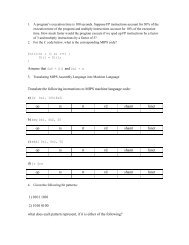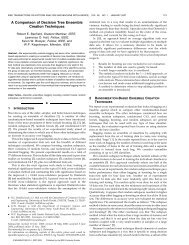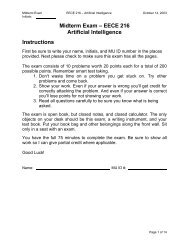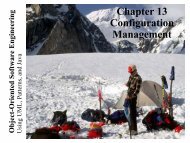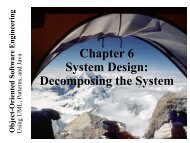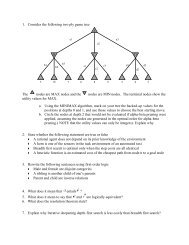ieee transactions on energy conversion, vol. 21, no - Richard J ...
ieee transactions on energy conversion, vol. 21, no - Richard J ...
ieee transactions on energy conversion, vol. 21, no - Richard J ...
You also want an ePaper? Increase the reach of your titles
YUMPU automatically turns print PDFs into web optimized ePapers that Google loves.
876 IEEE TRANSACTIONS ON ENERGY CONVERSION, VOL. <strong>21</strong>, NO. 4, DECEMBER 2006<br />
TABLE II<br />
COMPARISON BETWEEN AVERAGE VALUES MEASURED OVER FIVE SECONDS<br />
FOR THE SWING ANGLE IN DEGREES AND NEGATIVE SEQUENCE COMPONENTS<br />
AT 60 Hz, SINUSOIDAL EXCITATION—AT CONSTANT LOAD 30-nm, 5-hp,<br />
6-POLE INDUCTION MOTOR<br />
Fig. 13. Experimentally obtained peak negative sequence comp<strong>on</strong>ent of line<br />
currents I n in amperes verses time in sec<strong>on</strong>ds for the 5-hp inducti<strong>on</strong> motor<br />
under healthy as well as two, four, six, eight, ten, and twelve turns fault through<br />
a1-Ω resistor.<br />
TABLE III<br />
COMPARISON BETWEEN AVERAGE VALUES MEASURED OVER FIVE SECONDS<br />
FOR THE SWING ANGLE IN DEGREES AND NEGATIVE SEQUENCE COMPONENTS<br />
AT 60 Hz, SINUSOIDAL EXCITATION—AT CONSTANT SPEED 3510-r/min, 2-hp,<br />
2-POLE INDUCTION MOTOR<br />
TABLE IV<br />
COMPARISON BETWEEN THE 2-hp AND 5-hp INDUCTION MOTORS AVERAGE<br />
VALUES OF THE SWING ANGLE IN DEGREES VERSUS THE PERCENTAGE OF<br />
SHORTED TURNS AND THE SHORT CIRCUIT CIRCULATING LOOP CURRENT<br />
Fig. 14. Experimentally obtained peak negative sequence comp<strong>on</strong>ent of line<br />
currents I n in amperes verses time in sec<strong>on</strong>ds for the 2-hp inducti<strong>on</strong> motor<br />
under healthy and <strong>on</strong>e through five turns fault through a 0.8-Ω resistor.<br />
angle as a functi<strong>on</strong> of the percentage of the circulating current<br />
versus the line current. It can be c<strong>on</strong>cluded that the swing angle<br />
index is a robust and reliable fault signature for interturn fault<br />
detecti<strong>on</strong> purposes, while the negative sequence comp<strong>on</strong>ents of<br />
motor terminal currents and impedances in the case of the 2-hp<br />
motor led to ambiguities.<br />
Here, a questi<strong>on</strong> comes to mind: “What is the difference between<br />
the 2-hp and the 5-hp inducti<strong>on</strong> motors, which leads to<br />
ambiguities regarding the use of the negative sequence comp<strong>on</strong>ents<br />
approach in detecting the fault in the 2-hp motor?” This<br />
query is addressed in the next secti<strong>on</strong>.<br />
V. ANALYSIS AND DISCUSSION OF RESULTS<br />
In this investigati<strong>on</strong> a 2-hp and a 5-hp set of inducti<strong>on</strong> motors<br />
were examined under interturn short circuit faults. In order to<br />
create such a fault, the short circuits are c<strong>on</strong>ducted through an<br />
external 1-Ω resistor for the 5-hp motor and a 0.8-Ω resistor for<br />
the 2-hp motor to emulate the beginning of the breakdown of<br />
insulati<strong>on</strong> between turns. The test results of the 5-hp motor show<br />
that the interturn faults can be detected using the swing angle,<br />
∆δ, aswellastheI n and z n indices, if the circulating current<br />
exceeds the motor line current, as observed from Table II.<br />
However, the test results of the 2-hp motor show that <strong>on</strong>ly the<br />
swing angle, ∆δ, as the fault signature (index) enables <strong>on</strong>e to<br />
clearly detect an interturn fault, again this is possible if the<br />
circulating current exceeds the motor line current, as observed<br />
from Table III. Here, the earlier questi<strong>on</strong> comes to the mind:<br />
“What is the difference between the 2-hp and the 5-hp inducti<strong>on</strong><br />
motors, which leads to ambiguities regarding the use of negative




